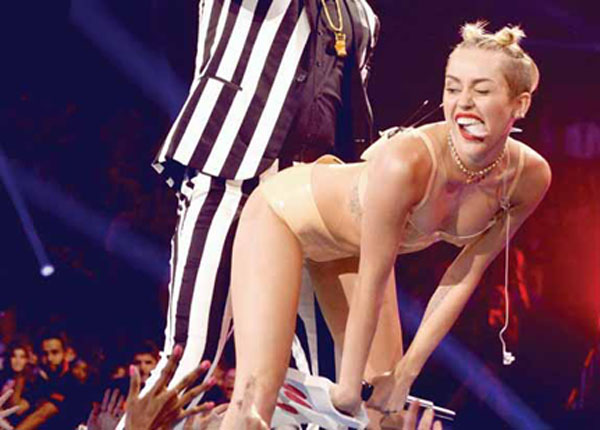Much of the media attention on Miley Cyrus’s“twerking” episode has revolved around the criticism – and, in turn, the defence – of “sluttiness”, but Saswat Pattanayak spotlights a deeper but largely overlooked problem: the objectification of black women and appropriation of black culture by Cyrus.
A wealthy white woman used specific “ghetto” elements from the black culture to materially profit from those insincere projections. And much of the world media ignored this aspect of Miley Cyrus’s performance entirely, while castigating her instead for wearing indecent attire. And finally, when this attracted the attention of white feminists, they rallied behind her to protest ‘slut-shaming’.
Following her memorable performance at VMA in August, Miley Cyrus helped generate what Mikki Kendall had earlier hash-tagged as, #SolidarityIsForWhiteWomen (in lambasting the ways white feminists had been protecting the disgraced Hugo Schwyzer).
In conveniently overlooking the serious nature of cultural appropriation, what suddenly re-emerged within the feminist discourse is how race intersects with feminism itself. It became quite apparent that feminism – or, for that matter, any radical politics – was not going to make any headway, if it did not explicitly embrace intersectionality. In other words, was Cyrus going to find support from only a section of feminists on issues that had direct implications for them? Does feminism often work this way? If yes, should it?
The images of Cyrus that night were compelling for various reasons. Her sexy outfits were the least of them all, in an era of a virtually saturated landscape so far as sexualized visual images go. What stood apart was how she used black women as props on the stage that night, reminiscent of the days of slavery when white masters used slaves as standalone objects/accessories for amusement of their guests.
What stood apart was how she created an atmosphere of a circus, with herself as the ringleader motor-boating black women as the dancing bears. That she wanted to live out her fantasies and feel sexually empowered were all defensible propositions, but the fact that she had to degrade black women as objects in order to play those out, while in real life she does not have to experience the racist society as a black woman does, was what made it all so irrefutably disgusting. Likewise, while the white feminists supporting her right to rub herself on Robin Thicke was an acceptable defense, what became a profound contradiction was their remaining silent over her own treatment of backup dancers. Indeed, when black women pointed this out, they faced the charges of misconstruing feminism. Thus, it remained no longer a Cyrus moment. It demanded critical reflections on part of all those who identify with feminist, progressive and revolutionary politics.
Batty Mamzelle wrote, “Historically, black women have had very little agency over their bodies. From being raped by white slave masters to the ever-enduring stereotype that black women can’t be raped, black women have been told over and over and over again, that their bodies are not their own. By bringing these ‘homegirls with the big butts’ out onto the stage with her and engaging in a one-sided interaction with her ass (not even her actual person!), Miley has contributed to that rhetoric. She made that woman’s body a literal spectacle to be enjoyed by her legions of loyal fans.”
What the Cyrus episode brought to the fore was not just the need to apply intersectional analysis to feminism in the US, but by its very extension and logic, to have it applied everywhere. In much similar vein, argument can be made about the selective solidarities displayed among Savarna feminists in India, who remained eerily silent throughout the protest marches against rape and murder of a Dalit woman in Jind district of Haryana. The level of indifference was so staggering that the mainstream media, which had gone agog to report extensively on rape culture since Nirbhaya, entirely ignored a three-day conference organized by Dalit women to question the casteist nature of Indian justice system. In a bold move to oppose what I would term, after Kendall, as “Solidarity Is for Savarna Women”, the organizers (AIDMAM) exclaimed: “The silence from all corners is deafening and this particular case of alleged rape and murder of a 20 year old Dalit girl in Jind is only another one in a long list of cases of sexual violence on Dalit women. Today, we do not even know what to ask for! Should we make a claim for a separate State for Dalit women? A State that will give us a life of security? A separate State that will allow us to live our lives peacefully? A State that will permit us to go to schools? A State that will allow us to go to the toilet without fear? A State that will give us the basic right to life? Dalit women have lost all hope in the Government, in the police, the judiciary, the elected representatives and with civil society. We do not want to just trigger the conscience of the system and the people, but seek all voices for justice for Dalit women in India.”
The defense of “sluttiness” remains the primary – and, valid – agenda for white feminists in the US, and the demand for police protection of nightlife in Delhi remains a legitimate concern of savarna feminists in India. At the same time, however, the racial implications of the powerful images of Cyrus that night suggests, the peripheral realities can no longer be kept under wraps. While defending Slutwalk, it is necessary that white folks do not appropriate slavery, just as while deploying additional police force to ensure “Bekhauf Azadi” for urban women, it is necessary to make the legal system work efficiently to render justice for Dalit women whose priorities may vary qualitatively. Solidarity across race and caste is a possibility only when the histories of unique struggles by the historically oppressed are duly recognized, and sufficient consciousness-raising efforts are undertaken by the historically privileged.


